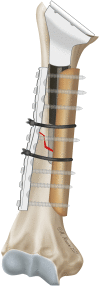A Long-Term Follow-Up of Post-Operative Periprosthetic Humeral Fracture in Shoulder Arthroplasty
- PMID: 34595045
- PMCID: PMC8477678
- DOI: 10.1177/21514593211039908
A Long-Term Follow-Up of Post-Operative Periprosthetic Humeral Fracture in Shoulder Arthroplasty
Abstract
Background: During the last decades, the growing number of shoulder replacement has increased the associated complications. Periprosthetic fractures have a low incidence but can be a severe clinical condition, especially in elderly population. There are still no guidelines to define the best treatment protocol for post-operative periprosthetic humeral fractures. Factors associated to these fractures and consequently the decision-making for the best treatment seem to be patient-related but also correlated with the type of implant. The aim of this study is to analyze the patient's risk factors, fracture pattern, implant type and treatment, evaluating the outcome with a long-term follow-up.
Methods: A retrospective study was performed on more than 2700 shoulder prostheses implanted over 10 years in two specialized centers, identifying 19 patients who underwent surgery for post-operative periprosthetic fracture. Gender, age, comorbidities, type of prosthetic implant, type of fracture, and cortical index of each patient were evaluated. All patients underwent surgery and were evaluated with a mean follow-up of 5 years with radiographic controls and functional assessment with the Constant-Murley score.
Results: Complete healing was achieved in 18 of 19 patients. All patients presented a lower Constant-Murley score than the pre-fracture score, there were no significant differences between prosthetic implants, and the cortical index was lower than the threshold level in more than 60% of cases.
Conclusion: The results of this study showed that a correct preoperative planning is essential to evaluate the type of implant and possible signs of stem mobilization. With a stable stem, it is preferable to maintain it and proceed to a synthesis. The decision process is more complex in periprosthetic fractures with a reduced cortical index, when some radiolucency lines are present in stems with high primary stability, because it is not always indicative of an unstable stem.
Level of evidence: Therapeutic III.
Keywords: periprosthetic humeral fracture; post-operative periprosthetic fracture; shoulder arthroplasty.
© The Author(s) 2021.
Conflict of interest statement
Declaration of Conflicting Interests: The author(s) declared no potential conflicts of interest with respect to the research, authorship, and/or publication of this article.
Figures




References
-
- Schairer WW, Nwachukwu BU, Lyman S, Craig EV, Gulotta LV. National utilization of reverse total shoulder arthroplasty in the United States. J shoulder Elb Surg. 2015;24(1):91–97. - PubMed
-
- Day JS, Paxton ES, Lau E, Gordon VA, Abboud JA, Williams GR. Use of reverse total shoulder arthroplasty in the medicare population. J shoulder Elb Surg. 2015;24(5):766–772. - PubMed
-
- Palsis JA, Simpson KN, Matthews JH, Traven S, Eichinger JK, Friedman RJ. Current trends in the use of shoulder arthroplasty in the United States. Orthopedics. 2018;41(3):e416–e423. - PubMed
-
- Kim SH, Wise BL, Zhang Y, Szabo RM. Increasing incidence of shoulder arthroplasty in the United States. J Bone Joint Surg Am. 2011;93(24):2249–2254. - PubMed
LinkOut - more resources
Full Text Sources
Research Materials

